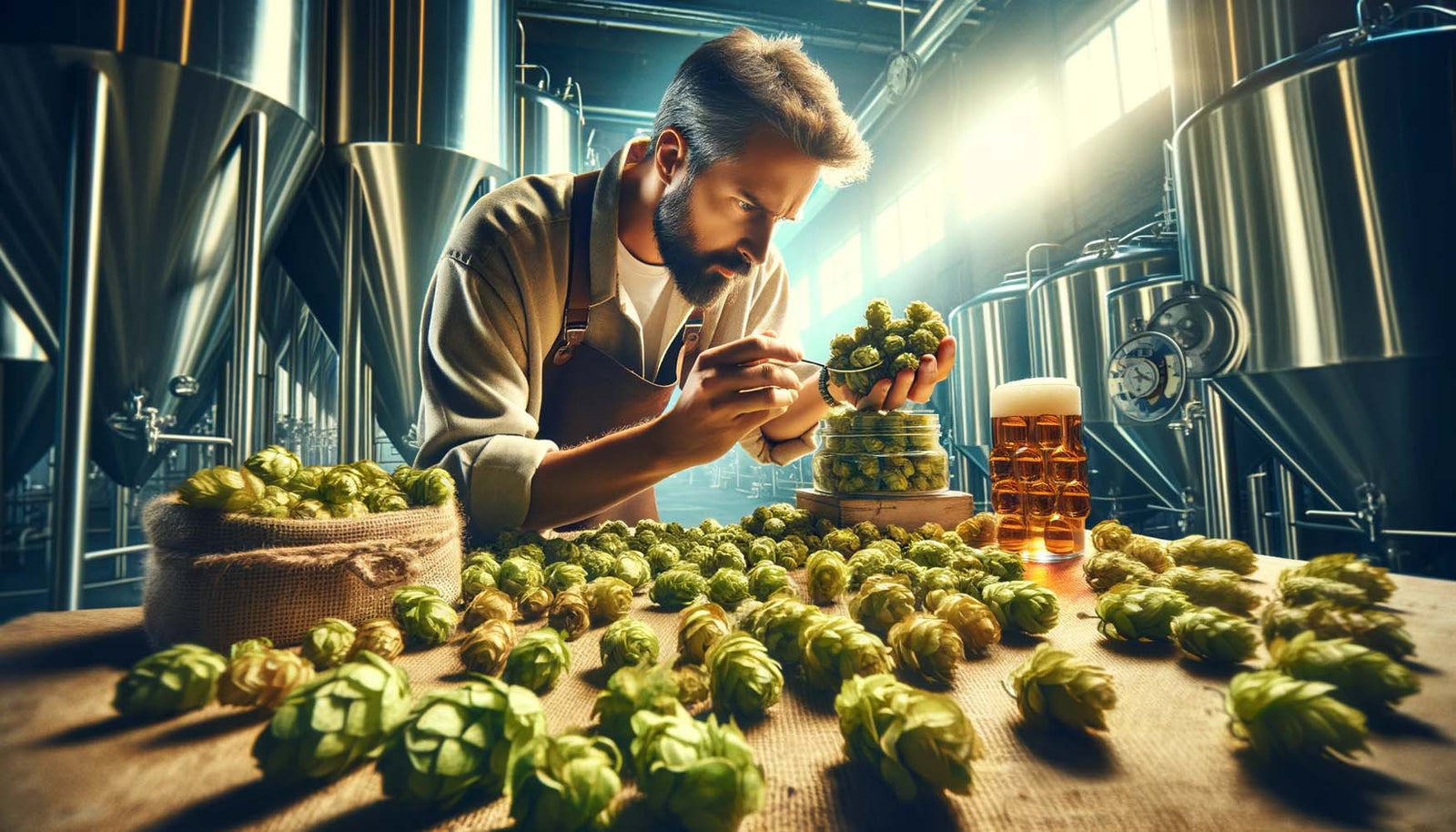Add description, images, menus and links to your mega menu
A column with no settings can be used as a spacer
Link to your collections, sales and even external links
Add up to five columns
Add description, images, menus and links to your mega menu
A column with no settings can be used as a spacer
Link to your collections, sales and even external links
Add up to five columns

Exploring the Latest Trends in Hop Usage
March 04, 2024 5 min read
Exploring the Latest Trends in Hop Usage
Hop usage plays a crucial role in brewing, impacting the flavor, aroma, and overall quality of beer. Brewers have long relied on these plant flowers to enhance their creations, but the way hops are used has evolved over time. This article will delve into the basics of hop usage, explore its historical context, examine current trends, and speculate about what the future holds. Additionally, we will examine how these trends shape beer flavors and the economic implications for brewers.
Understanding the Basics of Hop Usage
In order to fully appreciate the latest trends in hop usage, it is essential to understand the fundamental role that hops play in brewing. Hops provide bitterness, balance sweetness, and contribute to the overall aroma of the beer. They also act as a natural preservative, extending the shelf life of the final product. Brewer's use hops at different stages of the brewing process, including during boiling, fermentation, and maturation.
When hops are added early in the boiling process, they primarily contribute to bitterness. This bitterness is measured in International Bitterness Units (IBUs), with higher values indicating a more bitter taste. Hops added towards the end of boiling or during fermentation add aromatic qualities, such as floral, citrus, or herbal notes.
The Role of Hops in Brewing
Hops not only provide flavor and aroma to beer but also act as a natural stabilizer. The alpha acids in hops prevent the growth of bacteria and other microorganisms, ensuring beer remains fresh for an extended period. Additionally, the antimicrobial properties of hops inhibit the development of off-flavors, helping beer maintain its intended taste.
Furthermore, hops create a pleasant balance in beer by countering the sweetness of the malt. This balance is crucial in various beer styles, ranging from hop-forward India Pale Ales (IPAs) to more malt-focused Stouts and Porters. The careful selection and usage of hops can transform the beer's character, elevating it to new heights of complexity and enjoyment.
Different Types of Hops and Their Characteristics
Hop varieties come in various forms, each with its unique characteristics and flavors. The most commonly used hops fall into two main categories: aroma hops and bittering hops.
Aroma Hops:
- - Cascade: Known for its floral and citrusy aroma, Cascade hops are widely used in American craft brewing.
- - Saaz: Traditional European aroma hops, Saaz offers a pleasant, delicate spice and floral notes.
Bittering Hops:
- - Magnum: This high-alpha acid hop adds bitterness without overpowering hop flavor or aroma.
- - Nugget: Known for its strong and herbal characteristics, Nugget hops provide a robust bitterness profile.
There are countless other hop varieties available, each with its own unique flavor profiles and applications. Brewers often experiment with blends of different hops to create truly distinctive beers, pushing the boundaries of creativity and taste.
Moreover, the geographical origin of hops can also influence their characteristics. For example, hops from the Pacific Northwest region of the United States are known for their bold and resinous flavors, while hops from Germany tend to have more delicate and spicy notes.
Additionally, the timing of hop additions during the brewing process can have a significant impact on the final beer. Dry hopping, which involves adding hops during or after fermentation, can enhance the aroma and create a vibrant hop character without contributing much bitterness. This technique is commonly used in hop-forward styles like New England IPAs, where the focus is on juicy and tropical hop flavors.
Furthermore, the storage and handling of hops are crucial to preserving their quality. Hops should be stored in a cool and dry environment to prevent degradation of their essential oils, which are responsible for the aroma and flavor. Vacuum-sealed packaging and nitrogen-flushed containers are often used to maintain hop freshness.
As the craft beer industry continues to evolve, so does the exploration of hop usage. Brewers are constantly experimenting with new hop varieties, techniques, and combinations to create innovative and exciting beers. The world of hops is a vast and ever-expanding universe, offering endless possibilities for brewers and beer enthusiasts alike.
The Evolution of Hop Usage
To fully appreciate the latest trends in hop usage, it is important to explore the historical context of how hops have been utilized in brewing over the ages.
Historical Overview of Hop Usage
The cultivation and utilization of hops in brewing dates back centuries. The precise origins of hop usage are disputed, but the medieval European monasteries played a significant role in documenting and refining their usage. Hops gained popularity due to their preservative properties, which allowed beer to be stored and transported over long distances without spoiling.
As brewing practices evolved, so did the methods of hop usage. Initially, hops were primarily added for their bitterness properties. However, brewers eventually discovered the aromatic qualities of hops, leading to their incorporation during fermentation and maturation. This marked the beginning of a richer and more diverse hop usage in beer production.
During the Industrial Revolution, advancements in brewing technology further revolutionized hop usage. The invention of the hopback, a vessel used to infuse beer with hop aroma and flavor, allowed for more precise control over the hop character in the final product. This innovation paved the way for the development of distinct beer styles with unique hop profiles.
Modern craft breweries have taken hop usage to new heights, experimenting with different hop varieties from around the world. The concept of "dry hopping," where hops are added post-fermentation to enhance aroma without increasing bitterness, has become a popular technique among brewers seeking to push the boundaries of hop-forward flavors in beer. This continuous exploration and innovation in hop usage continue to shape the diverse and dynamic landscape of the craft beer industry.
As you continue to explore the latest trends in hop usage and refine your brewing craft, Bräu Supply is here to support your journey. Whether you're a seasoned microbrewer or a passionate homebrew enthusiast, our innovative all-in-one systems, like the Unibräu and Unibräu Pro, offer the highest quality brewing experience with 304 stainless steel and electric power at their core. Our HERMS system represents the pinnacle of efficient electric brewing, and our Unitank jacketed fermenters set the standard for quality. With the most available accessories in the business, our modular products are designed to meet your specific brewing needs without the need for customization. Elevate your brewing process and embrace the full potential of hop flavors with Bräu Supply's superior brewing systems and accessories. Check out our products and discover how we can enhance your brewing experience.
MORE ARTICLES HOW TO BREW BEER
Pressure fermentation: Methods and benefits
The art and science of barrel aging beers
Is decoction mashing worth it?
The simplified art of no sparge brewing
mastering cold crashing: enhancing beer clarity and accelerating aging process
Troubleshooting fermentation problems in brewing
The ultimate guide to Kveik yeast: Unleashing it's fermentation potential
Pressure fermentation in brewing: Benefits, downsides, equipment and techniques
Subscribe
Sign up to get the latest on sales, new releases and more …
Subscribe to our Newsletter for Early Access, Special Deals, and Informative Content!
Join our newsletter and become a part of our exclusive community. By subscribing, you'll gain access to a world of advantages:
1. Early Access to Sales:
Be the first in line for our exciting sales events!
2. Subscriber-Only Deals:
As a token of our appreciation, we offer exclusive deals and discounts just for our subscribers.
3. Quality Informative Newsletter:
Our newsletter isn't just about sales; it's also about enriching your knowledge.

